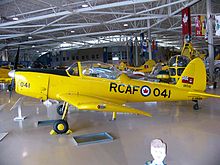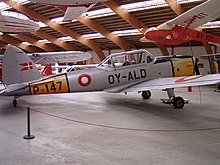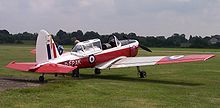de Havilland Canada DHC-1
| de Havilland Canada DHC-1 Chipmunk | |
|---|---|
 Chipmunk at Avalon Airport, Australia, 2005 |
|
| Type: | Trainer aircraft |
| Design country: | |
| Manufacturer: | |
| First flight: |
May 22, 1946 |
| Number of pieces: |
1292 |
The de Havilland Canada DHC-1 Chipmunk ( " chipmunk ") was a two-seat training aircraft from 1946, which of the standard training aircraft British military in the aftermath of the Second World War has been and wide in later versions use in civil applications such. B. found as an agricultural aircraft.
history
The DHC-1 Chipmunk was the successor to the legendary De Havilland Tiger Moth DH.82 - biplane designed. It first flew on May 22, 1946 in Toronto-Downsview . It was the first complete design of de Havilland Aircraft of Canada Ltd . The main developer was the Pole Vziewolod Jakimiuk . The prototype was equipped with a de Havilland Gipsy Major 1C with 108 kW (145 PS).
Two aircraft were tested by the Airplane and Armament Experimental Establishment at Boscombe Down . With its good-natured aerobatic characteristics, the Chipmunk immediately became the standard trainer of the Royal Air Force (RAF). Prince Philip got his first flying lessons on a chipmunk in 1952. The Royal Canadian Air Force (RCAF) also adopted the Chipmunk as the standard trainer.
A special variant is the Super Chipmunk built by Art Scholl. Equipped with a retractable landing gear and a more powerful engine as well as shortened wings, the Super Chipmunk was designed for spectacular show aerobatics.
218 chipmunks were built in Toronto by 1956, 1,014 units were built in Great Britain. 60 Chipmunks were built in Portugal from 1955 to 1960 under license from OGMA for the Portuguese Air Force . Chipmunks built in Canada were designated T.Mk 30 and included the DHC-1B-1 with the Gipsy Major 1C and the DHC-1-B2 with the Gipsy Major 10-3. Production was stopped after 158 machines were delivered. Another 60 machines were later produced for the RCAF. British-built versions of the Chipmunk are the T.Mk 10 and T.Mk 20 and the civilian T.Mk 21, 1,014 of which were built in the UK.
The Chipmunk Mk.23, which first flew on June 6, 1958, is a heavily modified single-seat version of the Chipmunk Mk.10 trainer aircraft. In the new version, the front cockpit was replaced by a container or tank that holds 254 kg of solid or 363.7 l of liquid material. The container space could also be used as a cargo space with a level floor or for a passenger seat. The rear seat has also been raised for better visibility. A device for spraying these materials in flight was attached to the wing's trailing edge across the span. The arrangement of the flaps was changed so that the stall occurred at lower flight speeds. This reduced the tipping speed with a full load for spraying to 70.8 km / h.
The British and early Canadian chipmunks were very different from the later RCAF and Lebanese models. The new models had bubble-like canopy glazing. The Chipmunk was also a successful civil aircraft since the 1950s. It was used for aerobatic training and as a spray aircraft in agriculture.
The RAF received 735 British-made chipmunks. The machines initially served in the University Air Squadrons . Some machines were used in the Cyprus conflict in 1958 and for flights in Berlin . They remained in service until 1996 and were then replaced by Scottish Aviation Bulldog , who in turn were replaced by Grob Tutor in 1999-2000. The last chipmunks were used in the Battle of Britain Memorial Flight for historic RAF aircraft.
Other countries such as Burma , Ceylon , Chile , Columbia , Denmark , Egypt , Ireland , Iraq , Israel , Jordan , Lebanon , Malaysia , Saudi Arabia , Syria , Thailand and Uruguay also used the machine.
Military users
-
 Egypt
Egypt
-
 Belgium
Belgium
- 2 pieces from 1948 for evaluation
-
 Denmark
Denmark
-
 Ghana
Ghana
-
 Ireland
Ireland
-
 Iraq
Iraq
-
 Israel
Israel
- 1 copy
-
 Jordan
Jordan
-
 Canada
Canada
-
 Kenya
Kenya
-
 Lebanon
Lebanon
-
 Malaysia
Malaysia
-
 Myanmar
Myanmar
-
 Norway
Norway
-
 Portugal
Portugal
-
 Rhodesia
Rhodesia
-
 Zambia
Zambia
-
 Saudi Arabia
Saudi Arabia
-
 Sri Lanka
Sri Lanka
-
 Syria
Syria
-
 Thailand
Thailand
-
 Uruguay
Uruguay
-
 United Kingdom
United Kingdom
Technical specifications
| Parameter | Data |
|---|---|
| crew | Flight instructor and student pilot |
| length | 7.75 m |
| span | 10.47 m |
| Wing area | 16.0 m² |
| height | 2.1 m |
| Empty mass | 646 kg |
| Takeoff mass | 953 kg |
| drive | a de Havilland Gipsy Major 8 ; 145 PS (108 kW) |
| Top speed | 222 km / h |
| Range | 445 km |
| Service ceiling | 5200 m |
Web links
- The Gatower Chipmunk WG466 at the Military History Museum of the Bundeswehr - Berlin-Gatow airfield
- RAF Museum
- Chipmunk in the colors of Skylark Aviation
- Royal Canadian Air Force Museum
- Two chipmunks at Quax, the association for the promotion of historical aircraft



